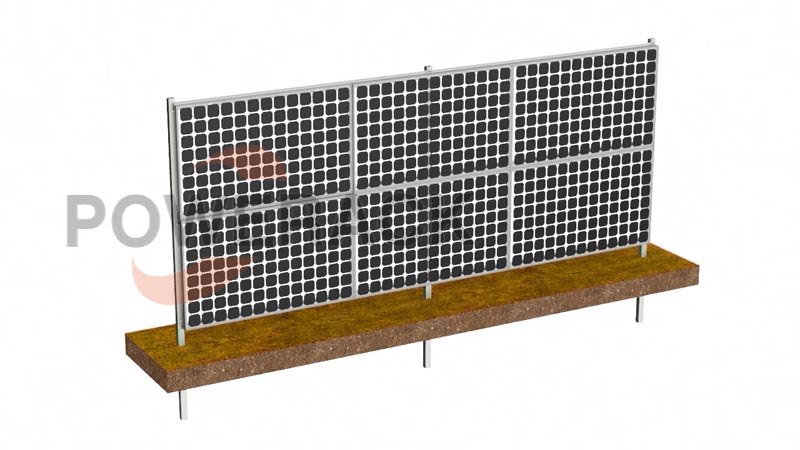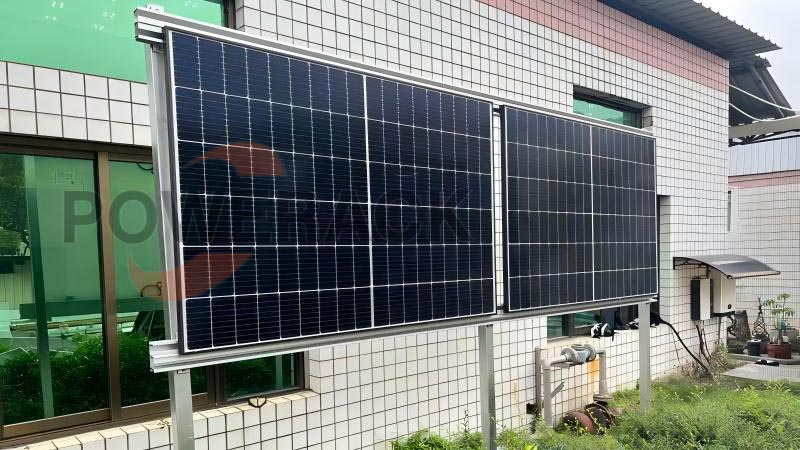
I. Alapvető funkciók
Fotovoltaikus kerítésrendszer: ① Védőszigetelés (ugyanaz, mint a hagyományos kerítés) ② Fotovoltaikus energiatermelés (tiszta energia biztosítása)
Hagyományos kerítések (acélháló, drótháló, betonfalak stb.): csak fizikai elszigeteltséget, lopásgátló, behatolásgátló és egyéb biztonsági funkciókat látnak el.
Külön fotovoltaikus rendszer (talaj/tető): csak fotovoltaikus energiatermelést biztosít, és külön biztonsági létesítményeket igényel.
II. Energiatermelési hatékonyság
Napelemes állványrendszer és kerítésrendszer: speciális állványrendszer használatával 5-8%-os éves energiatermelési növekedés érhető el; egytengelyes/kéttengelyes követőkonzol használata esetén a nyereség 15-25% is lehet.
Hagyományos kerítés: nincs energiatermelő kapacitás
Önálló fotovoltaikus rendszer: a hagyományos fix konzol hatásfoka 15–22%-kal nagyobb; 5–8%-os növekedés követőkonzol használata esetén (de további mechanikai költségekkel jár)
III. Foglalkozás/Térkihasználás
Napelemes kerítésrendszer: a kerítés által elfoglalt lineáris terület az energiatermelő felület, nem foglal el további földterületet, alkalmas határok, utak, mezőgazdasági területek, parkok és egyéb helyszínek kialakítására.
Hagyományos kerítés: csak egy vonalas területet foglal el, nem termel energiaértéket.
Egyedi fotovoltaikus rendszer: speciális földterületet vagy tetőterületet igényel, gyakran más létesítményekkel versenyez a földterületért.
IV. Kezdeti befektetés
Napelemes kerítésrendszer: szerelés + napelemes modul + elektronikus kerítés, a költség körülbelül 10-15%-kal magasabb, mint a hagyományos kerítésé (szerelési költség), de 20-30%-kal alacsonyabb, mint az önálló napelemes rendszeré (mivel nincs szükség további földterületre, infrastruktúrára)
Hagyományos kerítés: a legalacsonyabb költség, csak az anyag- és építési költség
Különálló napelemes rendszer: komplett napelemes rendszert igényel, mint például állványzat, alapozás, inverter, elosztódoboz stb., a költség a legmagasabb.
V. Üzemeltetési és karbantartási költségek
PV állványrendszer kerítés: ① Napelemek karbantartása (tisztítás, ellenőrzés) ② Kerítések karbantartása (korrózióvédelem, vandalizmus elleni védelem) Az üzemeltetési és karbantartási költségek összességében valamivel magasabbak, mint a hagyományos kerítéseké, de mivel az energiatermelésből származó nyereség ellensúlyozható, a nettó költség alacsony.
Hagyományos kerítés: A karbantartás elsősorban a rozsda megelőzésére és javítására szolgál, nagyon alacsony költséggel.
Egyedi napelemes rendszer: rendszeres tisztítás, inverter csere, felügyeleti rendszer karbantartása, üzemeltetési és karbantartási költségek a középkategóriában
VI. Biztonsági/védelmi teljesítmény
Napelemes kerítésrendszer: fizikai kerítés fizikai akadálya + elektronikus kerítés behatolásjelzője, nagyobb rugalmasság, összetett terepviszonyokhoz is alkalmazkodó, valós idejű megfigyelési funkcióval.
Hagyományos kerítés: csak fizikai akadály, nincs valós idejű riasztás, az alkalmazkodóképességet a terepviszonyok korlátozzák.
Külön fotovoltaikus rendszer: egy másik elektronikus kerítés vagy kamera telepítése szükséges ugyanazon védelem megvalósításához.
VII. Alkalmazható forgatókönyvek
Fotovoltaikus állványrendszer kerítéshez: mezőgazdasági fotovoltaikus rendszerek, parkok, gyárak, utak, határok, repülőtéri kifutópályák és egyéb védelemre + energiatermelésre szoruló helyek.
Hagyományos kerítések: lakóövezetek, ipari parkok, mezőgazdasági területek kerítései és egyéb olyan helyek, amelyek tiszta védelmet igényelnek.
Egyedi fotovoltaikus rendszer: nagyméretű fotovoltaikus erőmű, tetőre szerelt elosztott fotovoltaikus erőmű, épület függönyfala stb.
VIII. Szabályzatok/Támogatások
Fotovoltaikus kerítésrendszer: egyszerre igényelhet fotovoltaikus energiatermelési támogatásokat és biztonsági létesítményekre szánt speciális alapokat (egyes régiókban különleges támogatás áll rendelkezésre a „fotovoltaikus+biztonság” projektekhez).
Hagyományos kerítések: csak általános biztonsági létesítménytámogatások jelenthetők be.
Önálló fotovoltaikus rendszer: csak fotovoltaikus energiatermelési támogatás jelenthető be.